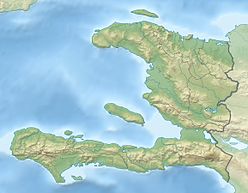This is a timeline of Haitian history, comprising important legal and territorial changes and political events in Haiti and its predecessor states. To read about the background to these events, see History of Haiti. See also the list of heads of state of Haïti.

The Cayemites are a pair of islands located in the Gulf of Gonâve off the coast of southwest Haiti. The two islands, known individually as Grande Cayemite and Petite Cayemite, are a combined 45 square kilometres in area. Petite Cayemite lies just west of the larger island, Grande Cayemite. The islands are approximately 35 kilometres (22 mi) east of the city of Jérémie and are in the administrative department of Grand'Anse.
The Montagnes du Cibao are located in Haiti. The highest point of the range, Morne du Cibao, is 2,280 meters above sea level, making it the third highest peak in Haiti, behind Pic la Selle and Pic Macaya.

Morne du Cibao is the third highest mountain in Haiti, after Pic la Selle and Pic Macaya. It is the highest point in the Montagnes du Cibao, and rises to an elevation of 2,280 metres (7,480 ft) above sea level.
Timoléon C. Brutus (1886–1971) was a Haitian politician and historian. He served as foreign minister of Haiti from 1946 to 1949. As a historian, Brutus wrote books about the leaders of the Haitian Revolution, Toussaint L'Ouverture and Jean-Jacques Dessalines. His most well-known works are Ranςon du Génie ou la Leςon de Toussaint Louverture (1945) and L'homme d'Airain (1946). His son, Edner Brutus, also became a prominent politician and historian.
Rulx Léon was a Haitian physician, historian, and journalist. Doctor Léon was "one of the most respected Haitian scholars." He was the author of a documentary on the history of Haiti entitled Propos d'Histoire d'Haïti (1945/1974).
Pradel Pompilus (1914–2000) was a Haitian writer. Pompilus "is considered one of the most respected Haitian scholars." He is best known for his three-volume study of Haitian literature.
Alain Turnier was a Haitian historian. He is the author of several best-selling books:
Gabriel Alix (1930–1998) was a Haitian painter. A native of Saint-Marc, Alix was a member of the Centre d'Art and painted still lifes, religious subjects, and animals.
Jackson Ambroise is a Haitian painter. Born in Milot, Ambroise paints landscapes and scenes of daily Haitian life. His paintings have been on display in Venezuela, France, Suriname, Guadeloupe, and Martinique.
Montas Antoine was a Haitian painter. Born in Léogane in 1926, he painted colorful street scenes and rural scenes. He died in 1988.
Georges Auguste is a Haitian painter. Auguste paints scenes of rural Haitian life in vibrant color. His style is known as "Raw Art."

Wilson Bigaud was a Haitian painter. Born in Port-au-Prince, Bigaud first worked with clay before becoming a painter. At the International Exhibit in Washington, D.C., in 1950 Bigaud won second place for a painting entitled "Paradise". He also painted a mural in the Holy Trinity Cathedral of Port-au-Prince which depicts the Marriage at Cana. He was a member of the artist group founded by Hector Hyppolite.
Roland Blain is a Haitian painter. A Port-au-Prince native, Blain typically paints nature scenes—jungles, animals, exotic birds, and landscapes.
Serge Moléon Blaise is a Haitian painter. Born in Cap-Haïtien, Blaise paints scenes from Haitian history, especially battle scenes. His younger brothers, Fabolon and Saint-Louis, are also noted painters of the region.
Maurice Borno (1917–1955) was a Haitian painter. Born in Port-au-Prince, Borno attended school in Haiti, New York City, and Paris. He was a founding member of the Centre d'Art and is considered a pioneer of Haitian art.
Abner Dubic is a Haitian painter. Born in Léogane, Dubic has exhibited his works in the United States and France. His works are sold in galleries in New York City, Chicago, and Paris.
Gervais Emmanuel Ducasse (1903–1988) was a Haitian painter. Born in Port-au-Prince, Ducasse painted historical scenes.
Murat Brierre or Murat Briere (1938–1988) was one of Haiti's principal metal sculptors. He was influenced by George Liautaud, but his work acquired its own, highly experimental style, often focusing on multi-faceted and conjoined figures, fantastically personified elements, and unborn babies visible within larger creatures. He sculpted works that reflected both Christian and Haitian Vodou themes. His works have been displayed in the United States, Mexico, Jamaica, and in Haiti's National Pantheon. Brierre was born in Port-au-Prince.






